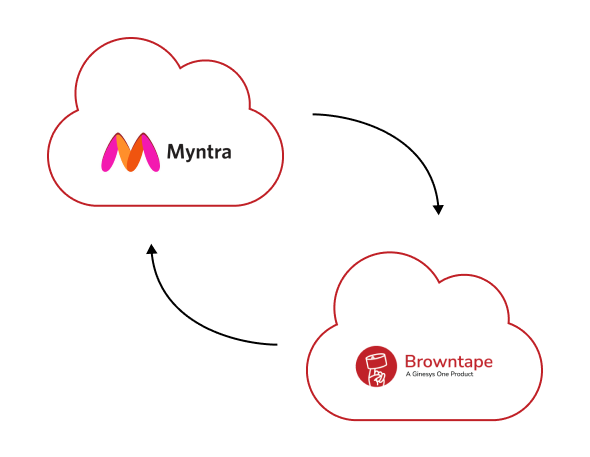Myntra is one among the 85+ integrations available on Browntape. Sync your entire business & watch it grow.

Myntra JIT is a business model where Myntra issues back-orders to sellers, basis orders received from customers.
These orders are grouped. For example, if there are 20 orders for 20 items from a particular seller, these orders are grouped to create one purchase order and issued to the seller. Hence this is popularly also referred to as the PO model.
Pros & Cons
The back-end platform used here is a third-party platform. Sellers need to process it via this platform or can integrate Myntra JIT to their Browntape accounts. This helps them operate their ecommerce business from a single dashboard. Browntape allows sellers to process these back-orders and daily POs via their Browntape account.
Myntra FBM, meaning ‘Fulfilled by Myntra’. While this is also a JIT (just in time) system, there are a few differences.
While it is called a B2C model, as the end-customer is billed, the seller does not pack the items as per the customer. Items are sent to the Myntra warehouse, where they are packed post quality check (QC).
In terms of transfer, instead of a back-order as seen in JIT, it is a stock transfer note (STN)- back-order that is issued by Myntra.
The seller tracks the goods via a gate pass, thus tracking returns becomes easier. It uses a third-party platform for processing; however, this can be integrated with Browntape.
Myntra M-Direct was Myntra’s first shift to “true B2C”. It comes close to other e-commerce platforms that most sellers are used to.
In Myntra M-Direct, a seller has receives orders as per each customer. The seller has to pick, do a quality check (QC) and pack the order as per the customer’s name & address.
The packages are then collected by Myntra’s logistics support and taken to a Myntra warehouse. Here they are sorted as per region & dispatched. It is akin to a hub & spoke system.
A seller has to invest in mandated infrastructure within his warehouse. This includes a packing table, printers, scanners, and Myntra specified packing material.
M-Direct is operational via Myntra’s own back-end platform. Thus the seller has to log into the portal to manage catalogs, listings, inventory, orders.
M-Direct gives a seller flexibility over his inventory, which is not possible on Myntra JIT or FBM.
However, a seller cannot use his own warehouse-management system in M-Direct. This becomes cumbersome for sellers who sell on multiple platforms. It leads to operational inefficiencies.
Myntra PPMP (Pure Play Marketplace) is an evolved fulfilment model by Myntra which allows sellers to operate the way they would in other marketplaces.
Benefits of Myntra PPMP
You can read more in detail about Myntra PPMP on our blog here.

The simple and intuitive interface of Browntape makes it a pleasure to use it everyday.
Read more

Browntape syncs with Amazon to keep your orders and stock up to date at all times.
Read more

Automatically gets any negative feedback associated with an order, so you know who to follow up with.
Read more

Browntape maintains the inventory across multiple stores automatically, you won’t have to.
Read more

Apart from Amazon, Browntape also connects to ebay and other marketplaces.
Read more

Easily mark orders as shipped in Amazon and add any required courier information.
Read more

Your data is yours to keep, analyse, plug and use as and when you wish.
Read more

You pay us as you scale.
Read more

An Ecommerce Software Built for the Complex Needs of Modern Retail Businesses
© Copyright Browntape 2024-2025. All rights reserved. Terms of Use | Privacy Policy